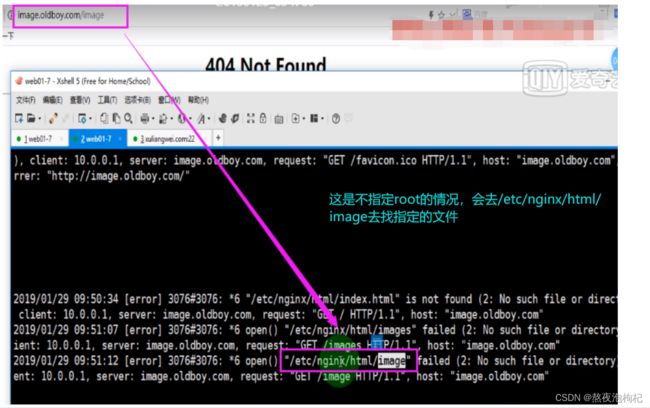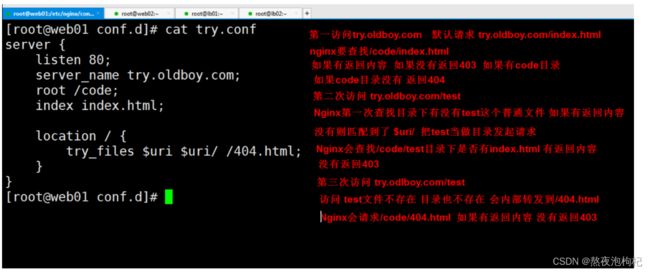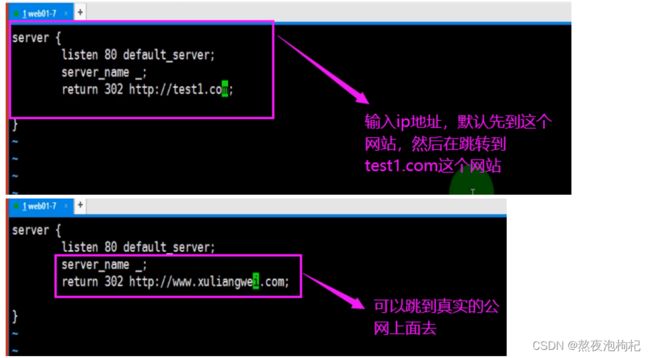Nginx常见问题(十七)
文章目录
-
- 1. Nginx多Server优先级
- 2. Nginx禁止IP直接访问
- 3. Nginx包含文件include
- 4. Nginx路径root与alias
- 5. Nginx try_file路径匹配
- 6. Nginx调整上传文件大小
- 7. Nginx优雅显示错误页面
- 8. 自我总结
1. Nginx多Server优先级
在开始处理一个http请求时,nginx会取出header头中的Host变量,与nginx.conf中的每个server_name进行匹配,以此决定到底由哪一个server来处理这个请求,但nginx如何配置多个相同的server_name,会导致server_name出现优先级访问冲突。
(1)准备nginx对应的配置文件:
[root@web01 conf.d]# cat server1.conf
server {
listen 80;
server_name localhost test1.com;
location / {
root /code/test1;
index index.html;
}
}
[root@web01 conf.d]# cat server2.conf
server {
listen 80;
server_name localhost test2.com;
location / {
root /code/test2;
index index.html;
}
}
[root@web01 conf.d]# cat server3.conf
server {
listen 80;
server_name localhost test3.com;
location / {
root /code/test3;
index index.html;
}
}
[root@web01 conf.d]#
(2)准备站点目录
[root@web01 conf.d]# mkdir /code/test{1..3}
[root@web01 conf.d]# echo test1 > /code/test1/index.html
[root@web01 conf.d]# echo test2 > /code/test2/index.html
[root@web01 conf.d]# echo test3 > /code/test3/index.html
(3)检查语法提示冲突,忽略并重启:
[root@web01 conf.d]# nginx -t
nginx: [warn] conflicting server name "localhost" on 0.0.0.0:80, ignored
nginx: [warn] conflicting server name "localhost" on 0.0.0.0:80, ignored
nginx: the configuration file /etc/nginx/nginx.conf syntax is ok
nginx: configuration file /etc/nginx/nginx.conf test is successful
[root@web01 conf.d]# nginx -s reload
nginx: [warn] conflicting server name "localhost" on 0.0.0.0:80, ignored
nginx: [warn] conflicting server name "localhost" on 0.0.0.0:80, ignored
[root@web01 conf.d]#
(4)浏览器访问测试
#根据ip访问
#1. 用户第一次访问,读取server1.conf配置返回结果
[root@lb01 ~]# curl 10.0.0.5
test1
#2. 此时将server1.conf修改为server4.conf重启nginx
[root@lb01 conf.d]# mv server1.conf server4.conf
[root@lb01 conf.d]# nginx -s reload
#3. 再次访问时,读取server2.conf配置返回结果
[root@lb01 conf.d]# curl 10.0.0.5
test2
(5)多Server_name优先级总结
再开始处理一个HTTP请求时,Nginx会读取header(请求头)中的host,与每个server中的server_name进行匹配,来决定用哪一个server标签来完成处理这个请求,有可能一个Host与多个server中的server_name都匹配,这个时候就会根据匹配优先级来选择实际处理的server。
多个server_name容易产生冲突,会按照如下顺序匹配
1.首先选择所有的字符串完全匹配的server_name。(完全匹配)
2.选择通配符在前面的server_name,如*.bgx.com www.bgx.com
3.选择通配符在后面的server_name,如bgx.* bgx.com bgx.cn
4.最后选择使用正则表达式匹配的server_name
5.如果全部都没有匹配到,那么将选择在listen配置项后加入[default_server]的server块
6.如果没写,那么就找到匹配listen端口的第一个Server块的配置文件
注意:当出现多个形同的server_Name情况下,配置文件排序有限使用则会先被调用,所以建议配置相同端口,不同域名,这样则不会出现域名访问冲突
2. Nginx禁止IP直接访问
如何通过default_server 禁止用户通过IP地址访问,或使用default_server进行导流
禁止直接通过IP访问
[root@web01 conf.d]# cat server4.conf
server {
listen 80 default_server; #默认优先返回;
server_name _; #空主机头或者IP;
return 503; #直接返回500错误;
}
default_server 如果用户用ip访问的话,直接默认访问这个有default_server的网站,而不是默认返回第一个了
导流:
[root@web01 conf.d]# cat server4.conf
server {
listen 80 default_server;
server_name _;
return 302 https://www.xuliangwei.com;
}
3. Nginx包含文件include
一台服务器配置多个网站,如果配置都写在nginx.conf主配置文件中,会导致nginx.conf主配置文件变得非常庞大而且可读性非常的差。那么后期的维护就变得麻烦。 假设现在希望快速的关闭一个站点,该怎么办
1.如果是写在nginx.conf中,则需要手动注释,比较麻烦
2.如果是include的方式,那么仅需修改配置文件的扩展名,即可完成注释 Include包含的作用是为了简化主配置文件,便于人类可读。
inlcude /etc/nginx/online/*.conf #线上使用的配置
/etc/nginx/offline #保留配置,不启用(下次使用在移动到online中)
4. Nginx路径root与alias
root与alias路径匹配主要区别在于nginx如何解释location后面的uri,这会使两者分别以不同的方式将请求映射到服务器文件上,alias是一个目录别名的定义,root则是最上层目录的定义。
root的处理结果是:root路径+location路径
alias的处理结果是:使用alias定义的路径
举个例子:
(1)使用root时,用户访问http://image.com/picture/1.jpg时,实际上Nginx会到/code/picture/目录下找1.jpg文件
[root@lb01 conf.d]# cat image.conf
server {
listen 80;
server_name image.com;
location /picture {
root /code;
}
}
(2) 使用alias时,用户访问http://image.com/picture/1.jpg时,实际上Nginx会到/code/目录下找1.jpg文件
[root@lb01 conf.d]# cat image.conf
server {
listen 80;
server_name image.com;
location /picture {
alias /code;
}
}
线上配置:
server {
listen 80;
server_name image.oldboy.com;
location / {
root /code;
}
location ~* ^.*\.(png|jpg|gif)$ {
alias /code/images/;
}
}
5. Nginx try_file路径匹配
Nginx try_file配置实例1
(1)配置nginx
[root@lb01 conf.d]# vim try.conf
server {
listen 80;
server_name try.oldboy.com;
root /code;
index index.html;
location / {
try_files $uri $uri/ /404.html;
}
}
(2)创建实例目录与文件
[root@lb01 conf.d]# echo try11111 > /code/index.html
[root@lb01 conf.d]# echo '404 404 404' > /code/404.html
(3)进行测试
第一种:
在浏览器输入域名:try.oldboy.com
因为浏览器自动添加成:http://try.oldboy.com/
这个时候没有uri,所以自动找/code/下的index.html
如果没有文件,则报403,有的话直接返回内容
如果没有/code目录,则会直接跳到/404.html
又因为默认在/下找index.html,所以完整路劲为:http://try.oldboy.com/index.html
如果在/code/index.html存在直接返回结果,文件不存在报404错误,如果目录不存在,则直接跳到/404.html
如果直接找输入 try.oldboy.com/index.html, 这个$uri就是/index.html,所以如果有这个文件就返回内容,如果没有就跳到/404.html
第二种:
在浏览器中输入域名:try.oldboy.com/test
先去判断test是否是一个文件,如果不是一个文件,则跳到$uri/,这个uri/就是/test/ 如果存在这个目录,则默认去找index.html,如果有这个文件则返回内容,如果没有则报403错误。如果没有/test/这个目录,则跳在/404.html
第三种:
如果前两种访问方式不存在目录,则直接跳到/404.html
小总结:
Nginx try_file配置实例2
#1. 配置nginx
[root@lb01 conf.d]# cat try.conf
server {
listen 80;
server_name try.oldboy.com;
root /code;
index index.html;
location / {
try_files $uri $uri/ @java; #当$uri和$uri/都匹配不到时,由后端的java来进行处理,名字可自定义,但一定要加@
}
location @java {
proxy_pass http://172.16.1.8:8080; #配置后端tomcat
}
}
#2. 配置后端tomcat
[root@web02 ~]# cd /usr/share/tomcat/webapps/ROOT
[root@web02 ROOT]# echo 'i am tomcat' > index.html
[root@web02 ROOT]# systemctl start tomcat
#3. 把文件都挪走
[root@lb01 code]# mv index.html index1.html /tmp/
#4. 测试访问
[root@lb01 code]# curl http://try.oldboy.com/index.html
i am tomcat
6. Nginx调整上传文件大小
在nginx使用上传文件的过程中,通常需要设置保存大小限制,避免出现413 Request Entity Too Large
nginx上传文件大小限制配置语法:
Syntax: client_max_body_size size;
Default: client_max_body_size 1m;
Context: http, server, location
nginx上传文件大小限制配置示例:
#也可以放入http层,全局生效
server {
listen 80;
server_name _;
client_max_body_size 200m;
}
7. Nginx优雅显示错误页面
error_page错误日志:
第一种配置情况(跳转网络地址)
#error_page配置的是http这种的网络地址
[root@lb01 conf.d]# cat error.conf
server {
listen 80;
server_name www.old.com;
root /code;
#error_page 404 http://www.baidu.com;
location / {
index index.html;
error_page 404 http://www.baidu.com;
}
}
第二种配置情况(跳转本地地址):
[root@lb01 conf.d]# cat error.conf
server {
listen 80;
server_name error.old.com;
root /code;
location / {
index index.html;
}
#error_page 403 404 /404.jpg;
error_page 403 404 /404.html;
location = /404.html {
root /code;
index index.html;
}
}
8. 自我总结
(2) 如果没有指定root,nginx默认去/etc/nginx/html/index.html,如果指定了uri,如果uri是image,那么就在/etc/nginx/html/image去找index.html




(3)优雅的显示错误页面
error_page错误日志:
开始做实验:




